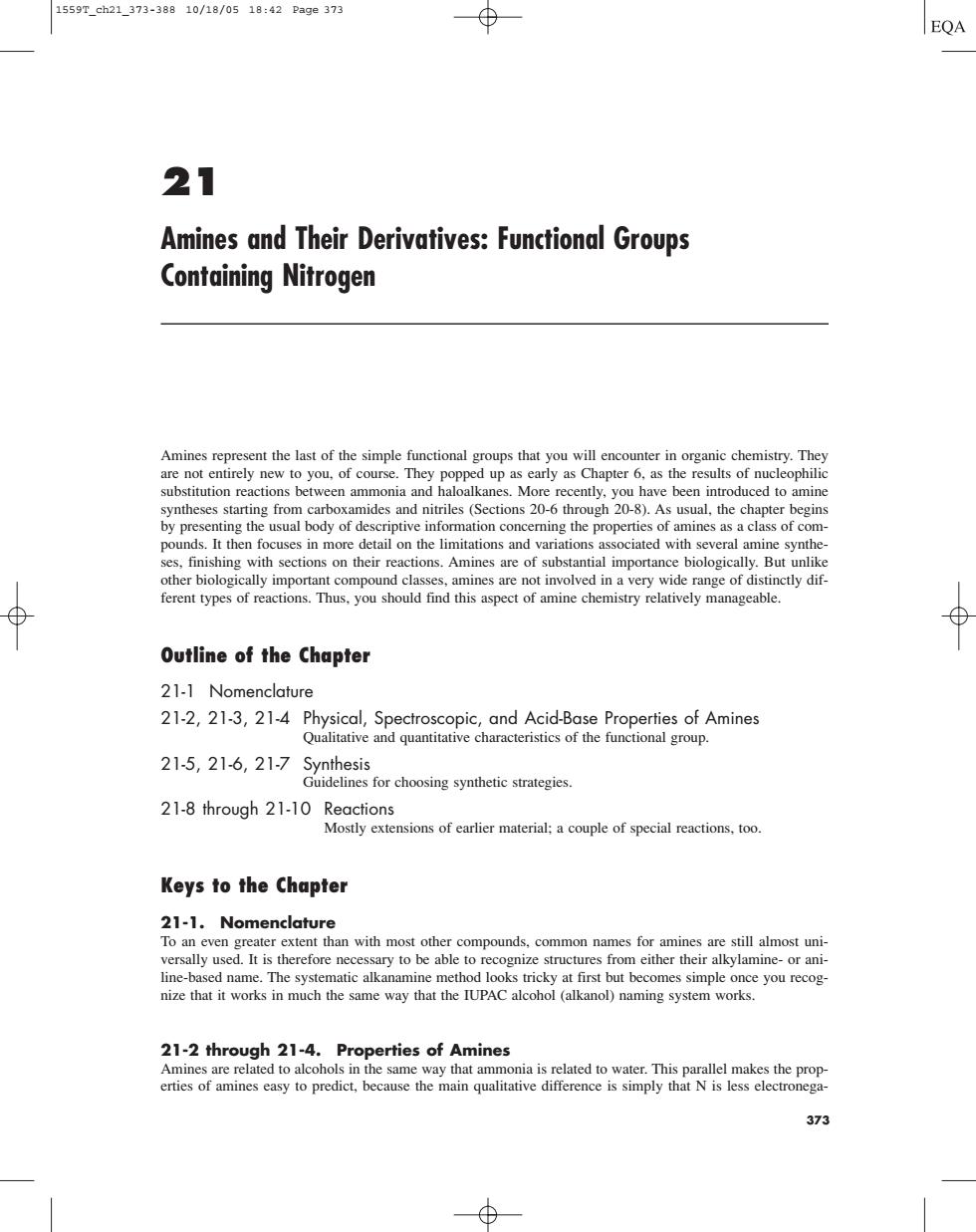正在加载图片...

1559T_ch21_373-38810/18/0518:42Pa9e373 EQA 21 Amines and Their Derivatives:Functional Groups Containing Nitrogen Amin that you will encounter in hemistry.The haitionteacioesbewemannoniaandhai lkanes.More recently,you have been introduced to amine pertes of amines as aclass of com- pounds.It then focuses in more detail on the limitations and variations associated with several amine e synthe sect ons.Amines areo ferent types of reactions.Thus,you should find this aspect of amine chemistry relatively manageable. Outline of the Chapter 21-1 Nomenclature 212,213,214l.so and Acid-Base Prope ics of the of Amines 21-5,21-6,21-7 Synthesis Guidelines for choosing synthetic strategies 21-8 through 21-10 Reactions Mostly extensions of earlier material:a couple of special reactions,too. Keys to the Chapter 21-1.Nomenclature To an even greater extent than with most other compounds.common names for amines are still almost uni our nize that it works in much the same way that the IUPAC alcohol (alkanol)naming system works. 21-2 through 21-4.Properties of Amines Amines are related to alcohols in the same 373 21 Amines and Their Derivatives: Functional Groups Containing Nitrogen Amines represent the last of the simple functional groups that you will encounter in organic chemistry. They are not entirely new to you, of course. They popped up as early as Chapter 6, as the results of nucleophilic substitution reactions between ammonia and haloalkanes. More recently, you have been introduced to amine syntheses starting from carboxamides and nitriles (Sections 20-6 through 20-8). As usual, the chapter begins by presenting the usual body of descriptive information concerning the properties of amines as a class of compounds. It then focuses in more detail on the limitations and variations associated with several amine syntheses, finishing with sections on their reactions. Amines are of substantial importance biologically. But unlike other biologically important compound classes, amines are not involved in a very wide range of distinctly different types of reactions. Thus, you should find this aspect of amine chemistry relatively manageable. Outline of the Chapter 21-1 Nomenclature 21-2, 21-3, 21-4 Physical, Spectroscopic, and Acid-Base Properties of Amines Qualitative and quantitative characteristics of the functional group. 21-5, 21-6, 21-7 Synthesis Guidelines for choosing synthetic strategies. 21-8 through 21-10 Reactions Mostly extensions of earlier material; a couple of special reactions, too. Keys to the Chapter 21-1. Nomenclature To an even greater extent than with most other compounds, common names for amines are still almost universally used. It is therefore necessary to be able to recognize structures from either their alkylamine- or aniline-based name. The systematic alkanamine method looks tricky at first but becomes simple once you recognize that it works in much the same way that the IUPAC alcohol (alkanol) naming system works. 21-2 through 21-4. Properties of Amines Amines are related to alcohols in the same way that ammonia is related to water. This parallel makes the properties of amines easy to predict, because the main qualitative difference is simply that N is less electronega- 373 1559T_ch21_373-388 10/18/05 18:42 Page 373